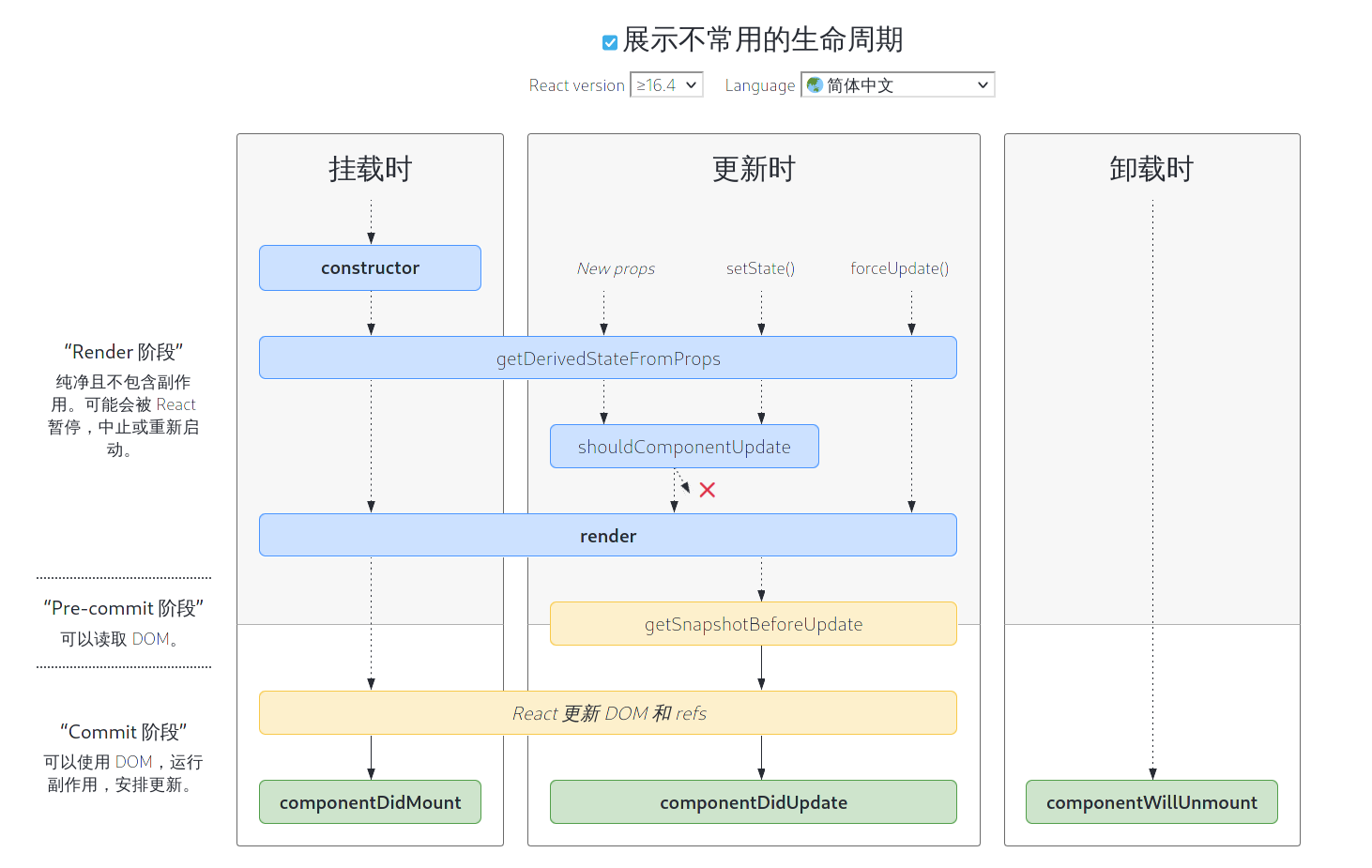React组件生命周期
2019 reactReact 定义类的组件时会提供的更多功能,如生命周期。
- 生命周期图表
- 三个阶段
- Mounting 挂载
- Updating 更新
- Unmounting 卸载
- Error Handling 错误处理
- 常用的生命周期
- 不常用的生命周期
- 错误处理
- HOOK
- 父子组件的加载顺序
- 参考链接
生命周期图表

三个阶段
react 的生命周期主要分为三种,挂载,更新和卸载。同时每个生命周期要经历三个阶段,分别是 render、pre-commit 和 commit。
-
Render 阶段:是指 render 函数执行完返回 jsx 结构之前的过程。该阶段纯净且不包含副作用。可能会被 React 暂停,中止或重新启动。
-
Pre-Commit 阶段:是指返回 jsx 结构到更新 DOM 之前的过程。该阶段可以读取 DOM。
-
commit 阶段:是指更新 DOM,以及更新成功之后的过程。该阶段可以使用 DOM,运行副作用,安排更新。
Mounting 挂载
在创建组件并将其插入 DOM 时,将依次调用以下方法:
Updating 更新
当更新 props 或者 states 是,可能会重新渲染组件,将依次调用以下方法:
- static getDerivedStateFromProps()
- shouldComponentUpdate()
- render()
- getSnapshotBeforeUpdate()
- componentDidUpdate()
Unmounting 卸载
当从 DOM 中移除组件时,将调用以下的方法:
Error Handling 错误处理
当组件在构建或者渲染时发生错误,将调用以下的方法:
常用的生命周期
render
在类组件中 render 是唯一必须需要的方法。render 函数是纯净的,render 函数不会去修改组件的状态。
返回的类型有如下:
- React elements,典型例子就是 JSX。
- Array 和 fragments
- Portals
- String 和 numbers 当返回字符串或者数字的时候,会渲染成文本节点。
- Booleans 或者 null 不会渲染。
constructor
如果不进行初始化 state 或绑定函数,可以省略。constructor 会在 React 组件挂载前调用。如果是通过 React.Component 子类实现 constructor,那么任何声明之前都应该调用 super(props)。同时,this.props是未定义的,无法调用。
constructor 只用在以下两个目的:
- 初始化 state
- 函数绑定
constructor(props) {
super(props);
this.state = { counter: 0 };
this.handleClick = this.bandleClick.bind(this);
}
不建议将 props 复制到 state 里面。因为这样子不是必要的(可以直接使用 this.props.xx 代替),还容易出现问题(更新 prop 属性不会更新 state)。
constructor(props) {
super(props);
// Don't do this!
this.state = { color: props.color };
}
只有在你不想更新 prop 时才使用这种模式,而在这种情况下,将 props 重命名为 initialColor 或 defaultColor 更有意义。然后,你可以在必要时通过改变键值来重置内部状态。详见:Recommendation: Fully uncontrolled component with a key
componentDidMount
在组件挂载之后会立即调用 componentDidMount(),请求 DOM 节点的初始化,初始化一个网络请求应该放这里。
componentDidUpdate()
componentDidUpdate(prevProps, prevState, snapshot) 在组件更新之后会立即调用 componentDidUpdate()。注意,首次渲染的时候不会触发。
这里可以用作组件更新之后的操作,同时,这里也可以通过对当前 props 和之前 props 比较之后进行一些操作。
componentDidUpdate(prevProps) {
// 典型应用(不要忘记 props):
if (this.props.userID !== prevProps.userID) {
this.fetchData(this.props.userID);
}
}
componentWillUnmount
在组件卸载或销毁之前会立即调用 componentWillUnmount。可以用来清除定时器,取消网络请求,取消订阅等。
不常用的生命周期
shouldComponentUpdate
shouldComponentUpdate(nextProps, nextState) 通过 shouldComponentUpdate() 可以让 React 知道组件在受到当前的 state 或 porps 中的影响下是否变化。默认是每次 state 更新的时候都会重新渲染,默认为 true。首次渲染或者当调用 forceUpdate() 该方法不知被调用。
这个方法仅适用于性能优化,不要依靠它来组织渲染,可能会导致 bug。使用内置的 PureComponent 代替手工的 shouldComponentUpdate。PureComponent 会对 props 和 state 进行浅层比较,从而减少一些不必要的更新。
当 shouldComponentUpdate 返回 false 时,componentDidUpdate,render 不会被调用。
static getDerivedStateFromProps
static getDerivedStateFromProps(props, state) 在调用 render 方法之前调用,包括挂载时和更新时。该方法要么返回一个更新 state 对象,要么返回 null 不更新。该方法的 state 取决于 props 的变化。
典型的应用场景:表单控件获取默认值。
getSnapshotBeforeUpdate
getSnapshotBeforeUpdate(prevProps, prevState) 该方法在页面 render 之前调用,state 已更新。它允许组件去获取信息在 DOM 更新之前,此生命周期返回的值会作为参数传递给 componentDidUpdate()。
错误处理
static getDerivedStateFromError()
static getDerivedStateFromError(error) 这个生命周期在错误抛出的时候调用。它接受错误作为参数,并且返回值更新 state。
componentDidCatch()
componentDidCatch(error, info) 此生命周期在后代组件抛出错误后调用。它接受两个参数
HOOK
useEffect 通过不同的参数设置可以模拟 componentDidMount, componentDidUpdate, componentWillUnmount 等生命周期。
// componentDidMount
useEffect(() => {
console.log('componentDidMount');
}, []);
// componentDidUpdate
useEffect(() => {
console.log('componentDidUpdate');
});
// componentWillUnmount
useEffect(() => {
return () => {
console.log('componentWillUnmount');
};
}, []);
注意:
- effect 的返回函数(清除函数)也会在每次 effect 生效重新渲染时执行,而不是只在卸载组件的时候执行一次,且会在 effect 运行之前执行。
- effect 里的 state 都是最新的。但 effect 里的返回函数(清除函数)的 state 是更新前的。
具体效果可以查看 codesandbox
父子组件的加载顺序
父子组件的生命周期顺序是如何的?
挂载时,子组件的挂载钩子会被先触发,卸载时,父组件的卸载钩子先被触发。
function Super() {
useEffect(() => {
console.log('Super Mounted.');
return () => {
console.log('Super UnMounted.');
};
}, []);
return (
<>
<div>Super</div>
<Sub />
</>
);
}
function Sub() {
useEffect(() => {
console.log('Sub Mounted.');
return () => {
console.log('Sub UnMounted.');
};
}, []);
return <div>Sub</div>;
}
代码实例:CodeSandBox
Super 组件在挂载卸载的过程中,分别输出:Sub Mounted,Super Mounted,Super UnMounted,Sub UnMounted